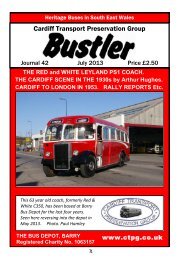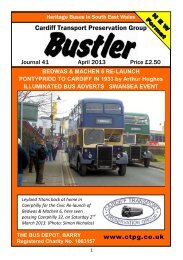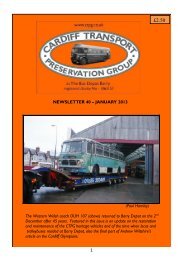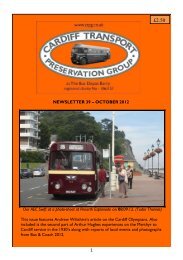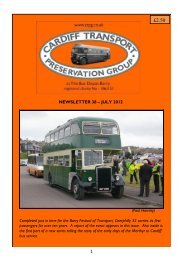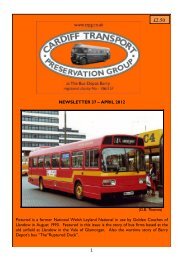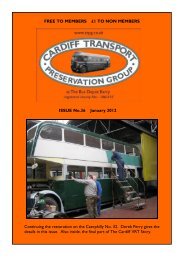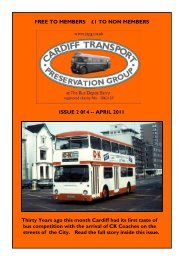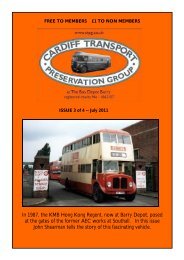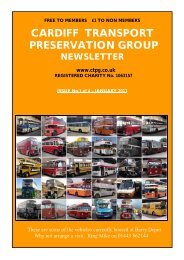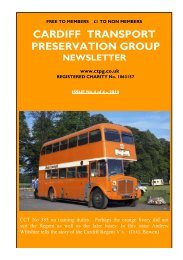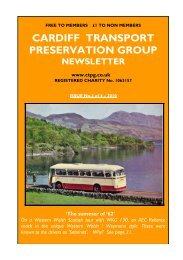You also want an ePaper? Increase the reach of your titles
YUMPU automatically turns print PDFs into web optimized ePapers that Google loves.
FREE TO MEMBERS<br />
£1 TO NON MEMBERS<br />
CARDIFF TRANSPORT<br />
PRESERVATION GROUP<br />
NEWSLETTER<br />
www.ctpg.co.uk<br />
REGISTERED CHARITY No. 1063157<br />
ISSUE No.2 <strong>of</strong> 4 <strong>–</strong> <strong>2010</strong><br />
DID THEY EXCEL?<br />
Inside this issue Andrew Wiltshire explains all about the<br />
Optare Excels, their short life with Cardiff Bus and their<br />
subsequent life with other operators.<br />
1 1<br />
1
A SLICE OF THE CAKE (1);<br />
Cardiff has seen two blue & white livered rival bus firms looking for a slice <strong>of</strong> the cake. For<br />
three years from Sept.1993, Cardiff Bluebird competed on several city routes. Seen here are<br />
MAU 619P one <strong>of</strong> the unusually styled ex. Nottingham Atlanteans at Beechley Drive, Pentrebane<br />
on 10.9.95 and one <strong>of</strong> the two new Darts, M200 CBB in Wood St. on 22..3.95 (Mike Street)<br />
2
CHAIRMAN’S MESSAGE;<br />
Welcome to the summer edition <strong>of</strong> the CTPG newsletter. We are now<br />
well into our annual calendar having just had this year’s first evening road<br />
run in Gwyn Gardiner’s National 2. A good run to Porth was undertaken<br />
with enough time for a pint whilst the National visited its old home. It is<br />
incredible that this bus is almost 30 years old!<br />
For our June run on Wednesday 16 th we have been invited for a tour <strong>of</strong><br />
the BBC at Llandaff. I hope that we can be transported down in summer<br />
sunshine aboard the freshly MOTed open top 434. Those who do not<br />
wish to visit the studios can visit the Heathcock pub.<br />
In July we will be travelling on the Leyland PAX 466F which will kindly on<br />
long term loan from Julian Peddle and in August, Mike Walker will be<br />
kindly providing something from his Bristol fleet.<br />
I have received confirmation that Merthyr College and Council will be<br />
supporting Bus & Coach Wales again this year, the date is set for Sunday<br />
5 th September.<br />
We attended the Bristol Harbour side Rally on Sunday 16 th May with our<br />
stall aboard HWO 323 and Richard’s MW coach. Both performed<br />
faultlessly and the weather remained mainly dry allowing us to have a<br />
good day on the stall.<br />
In terms <strong>of</strong> our running fleet, the addition <strong>of</strong> PAX provides us with a nice<br />
mix <strong>of</strong> old and new buses. My aim is to have Pontypridd No.8 on the<br />
road this year. Extensive bodywork repairs have been performed, so<br />
fingers crossed. Keep them crossed as well that we might see the Swift<br />
return at some point this year, as repairs are progressing well.<br />
Please keep supporting the group if you can, remember there is a lot<br />
more to do than drive and maintain the buses.<br />
Mike<br />
Tel; 01443 862144 Email; mikeystrad73@btinternet.com<br />
3
MARCH MEETING;<br />
It was pleasing to see a better attendance at this meeting.<br />
Around 30 members and guests gathered to support a presentation by<br />
our member John Jones. John gave us a tour <strong>of</strong> Wales using slides <strong>of</strong><br />
buses all taken in just one year, 1990. It was surprising to see the changes<br />
that 20 years has brought to both the bus operators and the vehicles.<br />
After the break Chris Taylor presented an informal quiz on some <strong>of</strong> the<br />
operators and buses we had seen. Many thanks were given to John and<br />
Chris.<br />
APRIL MEETING;<br />
Bob McCoy was the speaker for the April meeting, who although an<br />
Englishman, entitled his talk ‘Travel in the Valleys’. Mr. McCoy recalled<br />
the travel situation at Merthyr Tydfil in the early 1920’s when the town<br />
was served by the B.E.T. owned tramway and independent bus operators.<br />
In 1924 the Merthyr Council began operating buses, which Mr. McCoy<br />
said was a brave move in a depressed area with so much unemployment.<br />
After a break his theme moved on to the post WW2 years in Cardiff<br />
when the tramway system was on its last legs. We heard that politics<br />
played a part in retaining electric traction in the city including the<br />
trolleybus extension to Ely as late as 1955.<br />
MAY EVENING ROAD RUN;<br />
The first road run <strong>of</strong> the year was in Gwyn Gardiner’s pristine former<br />
National Welsh Leyland National 2, BUH 240V. We travelled up the Ely<br />
Valley to Porth to where this bus was first allocated in 1980. It later<br />
worked at several other depots including Cwmbran.<br />
The Mark 2 National was arguably the best version <strong>of</strong> a maligned model<br />
that certainly exudes a flavour <strong>of</strong> the 1980’s.<br />
N/Welsh only bought 3 examples whereas they bought over 200 <strong>of</strong> the<br />
original version. By 1988 N/Welsh were in dire straits and the 3 Mk 2’s<br />
were sold to Burnley & Pendle while they were still worth some money.<br />
Please turn to the back cover for a photo taken at this event.<br />
4
CARDIFF’S BUSES by Andrew Wiltshire<br />
Here today gone tomorrow……………the brief Excel era<br />
Fleet numbers: 201-215<br />
Registration number: R201-215DKG<br />
Chassis type:<br />
Optare Excel L1150<br />
Engine type:<br />
Cummins 6BT 6 cylinder turbocharged<br />
Gearbox:<br />
Allison B300R “World” series<br />
Overall length: 11.5m<br />
Brakes:<br />
Air<br />
Suspension:<br />
Air<br />
Body manufacturer: Optare integral<br />
Seating layout:<br />
B42F<br />
Year built: 1997<br />
Date <strong>of</strong> withdrawal: May to July 2000<br />
The Optare Excel was to be the first purpose built low-floor single decker<br />
to be produced by this Leeds based bus builder. It was a full-size bus<br />
launched in 1995 and replaced the more conventionally built Delta. It was<br />
constructed as a fully integral vehicle and the styling <strong>of</strong> the body, whilst<br />
quite obviously Optare, was very striking and incorporated a very deep<br />
windscreen above a simple flat front panel. The bus was available in four<br />
lengths, 9.6m, 10m, 10.70m and 11.50m and given chassis codes L960,<br />
L1000, L1070 and L1150 respectively. Seating usually ranged from 27 in<br />
the L960 up to 45 in the L1150, but varied to suit individual customers’<br />
requirements.<br />
The first example was N330 EUG, a 10 metre demonstrator built for<br />
Optare’s own use in 1995. This was followed in 1996 by four 9.6m<br />
examples for Thorpes <strong>of</strong> London and eight 10.7m models for Blackpool<br />
Transport. The Excel became very popular with orders coming from<br />
both large and small operators. The bus was updated in 1999 with the<br />
launch <strong>of</strong> the Excel 2, which <strong>of</strong>fered the Mercedes Benz 900 series engine<br />
as an option but retained the same Allison gearbox. This was available in<br />
three lengths 10.7m, 11.5m and 11.8m (L1180). The new long 11.8m<br />
version was favoured by Wilts and Dorset and Trent Buses.<br />
5
In all about 610 Optare Excels were built between 1995 and 2004 and<br />
included fourteen 11.8m left hand drive models for a Hungarian operator.<br />
A late Excel 2 model was YN53 ELH, an 11.8m model built for Optare’s<br />
own account, and later purchased by Welsh operator Richards Bros <strong>of</strong><br />
Cardigan with whom it was still operating in 2009.<br />
The early Excel did not have a particularly good reputation for reliability<br />
and many fleets took the opportunity to dispose <strong>of</strong> them prematurely.<br />
Excel 204 en route to Heath Hospital. (A.W.)<br />
Cardiff’s Excels<br />
It didn’t come as much <strong>of</strong> a surprise when it was announced that Cardiff’s<br />
first low-floor buses were to be from Optare, as they had previously<br />
supplied large numbers <strong>of</strong> the Metrorider model between 1990 and 1996.<br />
They were sold to Cardiff at a low price in an attempt to establish the<br />
model in the market place. Fifteen L1150 model Excels were ordered for<br />
delivery in 1997 and would take fleet numbers 201 to 215, marking the<br />
commencement <strong>of</strong> a new series. They were painted in a similar style to<br />
the seven Darts (023 to 029) delivered in 1995, being white with an<br />
orange ro<strong>of</strong> and a brown skirt. However the Excels had branding applied<br />
6
on all four sides which featured the slogans ‘Easyrider’, ‘Low floor bus’<br />
and ‘Easy Access’ with the fleet-name being Cardiff Bus, Bws Caerdydd.<br />
They started to arrive in October 2007 with the last three (213-215)<br />
arriving the following month. 201 and 202 were initially used for driver<br />
training in October, while 204 appeared at the Motor Show at the NEC in<br />
Birmingham the same month. November 3 rd saw the entry into service <strong>of</strong><br />
202 to 212, and before too long all fifteen were earning their keep. Most<br />
were used on services such as the 8 and 9A serving Heath Hospital,<br />
Grangetown and Cardiff Bay, but could at times, also be found working to<br />
Thornhill or Pontprennau.<br />
It was announced in 2000 that all fifteen would pass to Reading Transport<br />
to replace the last <strong>of</strong> the former Reading Mainline Routemasters. The<br />
reason being that in Cardiff, they were not considered to be a very<br />
suitable vehicle by either the Managing Director or the Fleet Engineer.<br />
This was down to three main problem areas that were identified at an<br />
early stage.<br />
The most serious issue concerned the body structure, and corrosion was<br />
identified at a very early stage and was most probably going to be a very<br />
major problem in due course, worse than the Metroriders! Secondly<br />
there were structural problems with gearbox, and the actual gearbox<br />
mountings breaking away from the under-frame <strong>of</strong> the bus. The final issue<br />
was that <strong>of</strong> fuel consumption, these buses were thirsty, returning figures<br />
as low as 6mpg at times. It was felt that they were unsuitable to form the<br />
basis <strong>of</strong> a ‘standardised’ fleet <strong>of</strong> full-size single-deck and midibus type<br />
vehicles from the same family that used the same common parts and units.<br />
The Dart on the other hand was considered ideal.<br />
Detail differences after two years in service saw 206 lose its Easyrider<br />
logo from its windscreen, while 207, 211,212 and 214 had much smaller<br />
logos than the rest. 204 had a small one then a large one. Towards the<br />
end <strong>of</strong> their short lives in Cardiff they were allocated to the Ely routes 17<br />
and 18. Their place on the Ely routes was taken by a batch <strong>of</strong> new SPD<br />
type Darts that entered service as 361-9/71 in August 2000.<br />
7
8
Life after Cardiff<br />
The first <strong>of</strong> the batch to leave Cardiff were sent to a bus works in<br />
Rotherham on 4 May 2000 for some refurbishment work, and by the end<br />
<strong>of</strong> the month 201 to 205 had departed Cardiff, and been allocated Reading<br />
fleet numbers 946 to 950. The remaining buses 206 to 210 went by the<br />
end <strong>of</strong> July becoming Reading 951 to 955, and followed by 211 to 215 in<br />
August becoming Reading 956 to 960.<br />
Excel 207 heads west over Ely Bridge (A.W.)<br />
Although Reading had a large fleet <strong>of</strong> Excels, the Cardiff Buses had several<br />
features that existing Reading examples did not have. After a spell <strong>of</strong> only<br />
eighteen months in Reading R206-215 DKG were sold to Eastbourne<br />
Buses in exchange for six Eastbourne Optare Spectra double-deckers.<br />
The ten Excels settled into life on the South Coast as Eastbourne (38 to<br />
47) and gained that operator’s attractive blue and cream livery. They<br />
were to remain unique at Eastbourne.<br />
Meanwhile back in Berkshire the Reading undertaking was starting to<br />
experience problems with the Excel model, and was looking to<br />
commence disposal <strong>of</strong> some early examples. By February 2005 they had<br />
withdrawn a number <strong>of</strong> their own examples and found a ready buyer in<br />
9
New Zealand. This exercise was repeated in March 2005 with the five<br />
remaining former Cardiff buses R201-5 DKG. They were driven down to<br />
Southampton docks on 17 March for loading onto the ship Tarago for<br />
onward shipment to New Zealand, travelling out via the Panama Canal.<br />
They had been purchased by Ritchies Transport <strong>of</strong> Auckland and upon<br />
arrival they were converted to dual-door forty seat buses as follows:<br />
new fleet no: new registration:<br />
R201 DKG…..…...671…………… (CSM 936)<br />
R202 DKG……….672…………… (CSM 933)<br />
R203 DKG……….673…………….(CSY 461)<br />
R204 DKG……….674…………… (CSY 465)<br />
R205 DKG… ……675 ……………(CSM 934)<br />
Entering service in the August, this is likely to be the last we hear <strong>of</strong> these<br />
five buses!<br />
R214 DKG in Eastbourne’s pleasing blue and cream livery (Mike Street)<br />
Back in the UK in 2005, Eastbourne had repainted at least one <strong>of</strong> the<br />
batch in their new predominantly blue fleet livery, but this did not prevent<br />
10
all ten from being advertised for sale by the end <strong>of</strong> the year. In 2006 they<br />
were sold as a batch to the South Gloucestershire Bus Company. They<br />
would be based at Patchway near Bristol for use on local services, and<br />
they gained an all over white livery. South Gloucestershire sold out to<br />
the Rotala Group in late 2007 and their stay at Patchway would be rather<br />
brief as reliability issues continued. With the exception <strong>of</strong> 208/10 which<br />
stayed behind to work for the newly named Wessex Connect fleet, the<br />
others moved north to Birmingham to work for the Central Connect<br />
operation, 208 and 210 later joining them.<br />
By April 2008 all ten were up for sale once again! It is thought at this<br />
stage that they all passed to Dawson Rentals (dealer) shortly after, who<br />
was faced with the task <strong>of</strong> ultimately finding buyers for them. However,<br />
initially, many went out as loan vehicles to a number <strong>of</strong> different small<br />
operators.<br />
In July 2009 that situation was believed to be as follows: 211 and 213 had<br />
found a new home with TM Travel <strong>of</strong> Halfway, Sheffield joining a small<br />
fleet <strong>of</strong> Excels with this expanding operator. Initially 208-10/12 went on<br />
loan to Red Arrow <strong>of</strong> Huddersfield while this new operator established its<br />
own fleet <strong>of</strong> buses. 210 spent a short spell on loan to Meakin <strong>of</strong> Crewe<br />
while 207/12/14/15 went on loan to Premiere <strong>of</strong> Nottingham by<br />
December 2008. It is thought that 207/12/15 were subsequently<br />
purchased by Premiere. 206 remained unused since leaving Central<br />
Connect, and its location is unknown. 209/10/14 had passed to Ventura<br />
Bus and Coach Sales by early 2009.<br />
In conclusion the story <strong>of</strong> Cardiff’s Excels (201 to 215) is one <strong>of</strong> a batch <strong>of</strong><br />
buses that should never have really been purchased by Cardiff Bus. Apart<br />
from the five that escaped overseas, the others seem to have been passed<br />
from one fleet to another. The only real attraction to a prospective<br />
buyer I suppose is that they are modern looking low-floor buses. Now at<br />
twelve years <strong>of</strong> age, their poor reliability and corrosion issues will mean<br />
the writing has to be on the wall for the ten that survive in the UK. Also<br />
<strong>of</strong> interest and worth mentioning briefly, as they are Welsh Excels, are<br />
the three 10.7m buses that Bebb <strong>of</strong> Llantwit Fardre purchased in 1999.<br />
Registered V78/9,81 JKG, they were sold by 2004 after a troubled<br />
11
existence, and passed initially to Weavaway <strong>of</strong> Newbury, but have since<br />
moved on.<br />
I would like to thank Gareth Stevens <strong>of</strong> Cardiff Bus and Alan Kreppel<br />
formerly <strong>of</strong> Cardiff Bus for their help with this article.<br />
Latest News; Cardiff Excel R209 DKG is now back in south Wales with<br />
Edwards Coaches, Llantwit Fardre. See back cover.<br />
Editor’s Note; The Excels may not have been an operational success in<br />
Cardiff but they were certainly good to drive. In Nov. 1997 your editor<br />
transferred to the Heath Hospital roster and was impressed by the<br />
handling and speed <strong>of</strong> the brand new Excels.<br />
By the way, Andrew’s latest book, the excellent ‘Independent Buses in<br />
South & West Wales’ is still available from the Ian Allan shop.<br />
------------------------------------------------------<br />
OOPS (2)<br />
This Western Welsh archive<br />
photograph is thought to<br />
have been taken in the late<br />
1940’s. It was said that one<br />
<strong>of</strong> the company’s two Ford<br />
V8 4x4 former gun tractors<br />
assisted with the recovery.<br />
The photo is the right way<br />
up, it’s jut the bus that isn’t!<br />
Bus 188 (KG 7038) was a<br />
1936 Roe bodied Leyland<br />
TS7 allocated to Aberdare.<br />
De-licensed in Sept. 1952 it<br />
was sold as scrap to James<br />
Thompson, Cardiff in Dec.<br />
1952.<br />
12
GROUP VEHICLE STATUS LIST;<br />
(CTPG vehicles under cover in Barry Depot)<br />
1951 LNY 903 Leyland Titan PD2/12 / Leyland L27/28R ex. Caerphilly 3 (u)<br />
1958 TAX 235 Bristol Lodekka LD6G / ECW H33/27RD ex. R&W L358 (rp)<br />
1958 XNY 416 Guy Arab LUF / Longwell Green B44F ex. Aberdare 14 (u)<br />
1958 889 AAX Leyland Tiger Cub PSUC1/13 / Weymann B44F ex. Jones 98 (rc)<br />
1961 XUH 368 Leyland Titan PD2A/30 / MCW H36/28F ex. Cardiff 368 (u)<br />
1964 ABO 434B Guy Arab V / Neepsend O37/28R ex. Cardiff 34 (rc)<br />
1965 GNY 432C Leyland Titan PD3/4 / Massey L35/33RD ex. Caerphilly 32 (rp)<br />
1966 EDW 68D Leyland Atlantean PDR1 / Alexander H74F ex. Newport 68 (rc)<br />
1968 JKG 497F Daimler Fleetline CRG6 / Park Royal H42/33F ex. Cardiff 497 (rp)<br />
1969 UTG 313G AEC Regent V 2MD3RA / W/brook H34/26F ex. PUDC 8 (rp)<br />
1969 OUH 177G Leyland Leopard PSU3A / Plaxton C49F ex. WWOC 177 (rp)<br />
1971 TKG 518J Leyland Leopard PSU4A / W/brook C45F ex. WWOC 1518 (o)<br />
(converted to recovery vehicle1985)<br />
1986 C101 HKG Ford Transit 190 / Robin Hood B16F ex. N/Welsh 1 (rp)<br />
1996 N143 NTG Optare Metrorider / Optare B31F ex. Cardiff 143 (o)<br />
1996 P164 TNY Mercedes 711D / Plaxton B27F ex. Rhondda Buses 164 (o)<br />
(CTPG vehicles in restoration away from depot)<br />
1947 CUH 856 Leyland Tiger PS1 / ECW B35R ex. WWOC 856 (rp)<br />
1956 LKG 678 AEC Regent V MD3RV / P. Royal H33/28R ex. WWOC 678 (rp)<br />
1968 MBO 512F AEC Swift MP2R / Alexander B47D ex. Cardiff 512 (rp)<br />
13
(Vehicles in storage away from depot)<br />
1969 PKG 532H Daimler Fleetline CRG6LX / W/brook H74D ex Cardiff 532 (u)<br />
1974 PKG 587M Bristol VRT/SL6G / ECW H43/31F ex. Cardiff 587 (u)<br />
1982 NDW 407X Volvo Ailsa B55 / N/Counties H39/35F ex. Cardiff 407 (o)<br />
1990 G258 HUH Leyland Lynx LX2R / Leyland B49F ex Cardiff 258 (o)<br />
(Non CTPG owned vehicles at Barry Depot)<br />
1950 HWO 323 Leyland Tiger PS1/1 Lydney C33F ex. Red & White C350 (rc)<br />
1958 964 DTJ Leyland Tiger Cub PSUC1/1 Weymann B44F ex. Merthyr 100 (rc)<br />
1960 TUH 13 Albion Nimbus / Harrington DP30F ex. WWOC 13 (rp)<br />
1963 408 DBO AEC Regent V 2DR3RA / East Lancs H35/28R ex. Cardiff 408 (rp)<br />
1966 FUH 370D Leyland Tiger Cub PSUC1 / P.Royal B43F ex. WWOC 1370 (rc)<br />
1966 KNY 495D AEC Regent V 2MD3RA / NCME H37/27F ex. Rhondda 495 (rc)<br />
1966 EDV 505D Bristol MW6G / ECW C39F ex. Western National 1423 (rc)<br />
1968 PAX 466F Leyland Titan PD3/4 / Massey L35/33RD ex. Bedwas & Machen (x)<br />
1972 WUH 585K Daimler Fleetline CRL6 / MCW H43/31F ex. Cardiff 585 (rp)<br />
1973 NNY 817L Bedford YRT ? Plaxton C53F ex. Sidney Davies, Penygraig (rp)<br />
1976 LUH 105P Bristol LHS6L / ECW DP27F ex. Cardiff 105 (rp)<br />
1976 OJD 45R Bristol LH6L / ECW B45F ex. London Transport BL45 (o)<br />
1986 C42 CKG Leyland Tiger TRTTL11 / East Lancs DP49F ex. Islwyn BT 42 (o)<br />
(o) original (u) unrestored (rp) restoration in progress (rc) restoration completed.<br />
(x) due June <strong>2010</strong><br />
14
DEREK’S LOG;<br />
(Now that we are approaching the finishing touches to the depot, on most<br />
Fridays and Saturdays, Derek Perry, Alan Poole and their small team have<br />
returned to restoration work on the group buses. Here is Derek’s log <strong>of</strong><br />
progress on the Leyland PD3, GNY432C.)<br />
Repairs were needed to the supports for the body side panels with<br />
cutting and fitting wood in-fills, plus a wood frame around the fuel tank<br />
filler. Some <strong>of</strong> the panels have been paint stripped and re-fitted, others<br />
have been replaced with new panels cut from sheets that have been<br />
purchased. All side panels up to the driver’s door have now been refitted.<br />
We then moved our attention to the last corner, the O/S front which has<br />
the complication <strong>of</strong> the drivers door, and two steps. While I was away<br />
for four weeks Alan removed the trim and panels to reveal the usual rust<br />
and rot problems. New angle iron has been cut, welded and bolted into<br />
two <strong>of</strong> the down stays.<br />
Now for the driver’s sliding door, the top runner was cleaned and<br />
lubricated and is working well. The bottom <strong>of</strong> the door has a length <strong>of</strong><br />
steel fitted which should run in a channel in the body. What is left <strong>of</strong> this<br />
channel has been removed and used as a rough guide to making and fitting<br />
a replacement <strong>of</strong> steel angle iron framing with timber inserts. This made a<br />
strong tidy job. Attached between this and the curved angle support for<br />
the wing, is a steel support for the top step. Nuts were welded to the<br />
back so that after the panels are fitted the step is fed into place and<br />
countersunk bolts went right through to hold it solid. In theory this is<br />
fine but in reality the top step has disintegrated and the only replacement<br />
that can be found is smaller. We therefore made the decision to use the<br />
bottom step in the existing frame at the top and put the smaller<br />
replacement step at the bottom where new supports will have to be<br />
made anyway.<br />
The curved angle iron to hold the wing is twisted and cannot be<br />
straightened in place, so we cut it <strong>of</strong>f, reshaped it in the vice and welded it<br />
back on. Then we re-bolted the wing to it and re-fixed the bottom stays<br />
to the last upright. A new body panel has been cut with a hole for the<br />
15
step, and shaped around the wing. Panels have also been made and fitted<br />
to the inside, thus filling the gap between the door runner and the floor.<br />
The wing has taken a hammering over its life span, and has been patched<br />
and finished with body filler which is flaking <strong>of</strong>f. After cleaning <strong>of</strong>f, new<br />
layers <strong>of</strong> filler have been applied and rubbed down. The door had been<br />
removed to facilitate these repairs, while it was <strong>of</strong>f it was stripped <strong>of</strong> its<br />
old paint and on checking it has proved to be in good condition.<br />
New body trim strips have arrived and we started with a half round piece<br />
half the length <strong>of</strong> the bus under the windows, this has been cut to length,<br />
drilled, countersunk and fitted. A long piece <strong>of</strong> the wider flat trim has<br />
been cut into lengths, drilled and countersunk, and fitted as the five<br />
vertical trims necessary for that side.<br />
A sheet <strong>of</strong> checker plate arrived and using the new and old panels as<br />
patterns, a new panel has been cut from it complete with holes for the<br />
steps. It was placed over the new panelling and drilled and riveted. The<br />
top step was fitted with counter sunk bolts right through into its support<br />
plate. The bottom step was riveted on with a support bracket up to the<br />
16
chassis. Around the wing needed a half round trim, this we curved into<br />
shape, (easier than we thought) drilled and screwed.<br />
There is a seal on the rear pillar with a trough on the door that fit<br />
together when the door is closed and as they are in good condition they<br />
do not need attention.<br />
At this time another group member has joined us, namely Peter Smith. He<br />
has been helping with the depot decoration from time to time but is now<br />
keen to put some time in on bus repairs. Together we studied the front<br />
<strong>of</strong> the driver’s door where a section <strong>of</strong> rubber sheet acts as a seal that<br />
needed replacing. A piece <strong>of</strong> angled aluminium that holds this in place was<br />
removed, a piece <strong>of</strong> rubber matting cut and the angle refitted to hold it in<br />
place. A final cleaning and a coat <strong>of</strong> grey primer made the door ready for a<br />
trial refit. Peter drilled, counter sunk and screwed the top edge <strong>of</strong> the<br />
checker plate, and also finished the top <strong>of</strong> the step into the cab with a<br />
section <strong>of</strong> checker plate cut to fit with a length <strong>of</strong> ridged kick plate. The<br />
door catch has also been refitted to the door pillar.<br />
With the scaffold tower placed at the rear <strong>of</strong> the bus I accessed the<br />
outside <strong>of</strong> the emergency door and with Alan Poole on the inside we<br />
freed <strong>of</strong>f and turned the handle. The door slid down in our waiting hands<br />
17
as what was left <strong>of</strong> the hinge screws fell out <strong>of</strong> the top frame, just as we<br />
had anticipated. The door is made up <strong>of</strong> a wood frame with an outside<br />
aluminium cover with two window panels. With the locking bar, catches<br />
and handles removed the inside covering <strong>of</strong> Formica, which as the glue has<br />
dried out with age, came <strong>of</strong>f easy with out damage. The outer cover was<br />
carefully removed to reveal a wood frame that is not too bad for its age.<br />
The steel hinge screws had rotted the timber around them, so two pieces<br />
<strong>of</strong> oak have been cut and fitted allowing the hinges to be re-screwed.<br />
Around the edge <strong>of</strong> the frame was a strip <strong>of</strong> steel over which the outer<br />
cover fits. Very little <strong>of</strong> this strip was left, and knowing the effects <strong>of</strong><br />
mixing steel with aluminium we are trying to replace this with aluminium.<br />
We will check if this is stiff enough, if not, at least we will have good<br />
templates to mark out steel ones.<br />
Alan has striped the paint <strong>of</strong>f the outer cover. I am pleased to say that<br />
with a small repair to one corner and a little panel beating it can be reused.<br />
Cleaning and painting the back has taken place, so we are ready for<br />
a trial re-assemble.<br />
UTG313G AEC Regent V<br />
This bus has stood around for some time. We have all looked at it and<br />
realized that the work done previously was not done with enough care.<br />
The alignments left a lot to be desired and work was put on hold for a<br />
while. Things changed with the arrival <strong>of</strong> a new member Richard Fitzjohn.<br />
He has a background <strong>of</strong> coach building and a yearning to be busy, so after<br />
more discussion we are having another look at it. We will go with Mac<br />
Winfield’s suggestion and start with the back emergency door and work<br />
our way round from there. News travels fast and Graig Boanas was given<br />
the job <strong>of</strong> wiring the rear end before any panels go on.<br />
The lower panel to the right <strong>of</strong> the door appears to be in good condition<br />
so we fitted it back into place. Luckily looking through the bus, a box was<br />
found containing various parts, including door handles and catches, plus<br />
hinge balls and bolts.<br />
Looking at the door, we find the first thing to do is rebuild the bottom<br />
cross member. The outer skin had already been eased <strong>of</strong>f at the bottom<br />
to access this so the old metal was cut <strong>of</strong>f and a channelled bar has been<br />
18
found and welding into place. At the same time a new wood block was<br />
fitted for the bottom hinge screws, the door skin has been gently refitted,<br />
and the other two hinges have been fitted with new screws.<br />
The door opening has previously been worked on with a new wood frame<br />
top and sides. New narrow edge panels on one side had been cut and put<br />
in place loosely without fixing. With a little work the other side panels<br />
will be usable. The bottom wooden step was loosely in place but when<br />
we tried to put the door into position on the hinges, the centre hinge did<br />
not line up and the step proved to be too high. On removing this step<br />
and a certain amount <strong>of</strong> wood from the left pillar the door closed, but<br />
overhung at the bottom instead <strong>of</strong> fitting flush the same as the rest <strong>of</strong> the<br />
door. After much puzzlement we realised the hinges on the body are<br />
three different lengths, the longest at the top and the shortest at the<br />
bottom, the last repairers had fitted the shortest hinge in the middle.<br />
(This reinforces the reason why everybody walked away from this job).<br />
On removing the bottom step, we reversed the angle iron to fix the floor<br />
to the inner panel and changed the hinges around then refitted the door.<br />
19
We now have the hinges lined up and the door fits flush all around. The<br />
previous repairers had made up angle plates for the front edge <strong>of</strong> the<br />
door frame and we have found the original beading strips, drilled and<br />
riveted these back in place, thereby holding the angle plates in place.<br />
The angle plates for the rear <strong>of</strong> the door were in the large box <strong>of</strong> bits that<br />
came with the bus; these have been tidied up and put into place. The door<br />
catches and locking bar have been sorted and a section <strong>of</strong> checker plate<br />
has been cut and fitted to the step.<br />
The rear curved corner body panel was missing so a new one has been<br />
cut, curved and fitted and a new half round trim has been fitted. Offering<br />
up the two flat body panels across the rear caused a flurry <strong>of</strong> comments<br />
from the purists about the positioning <strong>of</strong> the number plate which the last<br />
repairer, a long time ago, fitted flush onto the panel at the top. Mac<br />
obtained a recessed panel which we fitted lower down so that the plate<br />
and lamp can be fitted in its original position.<br />
---------------------------------------------------<br />
OBITUARY;<br />
The Group is saddened to report the death on 23 rd April <strong>of</strong> our<br />
member Bill Price <strong>of</strong> Llantwit Major. Although Bill was unable to<br />
attend many meetings he was always ready to help at our Barry &<br />
Merthyr rallies. He will be missed. The group was represented at his<br />
funeral.<br />
20
DATES FOR YOUR <strong>2010</strong> DIARY;<br />
6 th June; Barry Festival <strong>of</strong> Transport & Open Day.<br />
16 th June; Evening Road Run to The BBC studios at Llandaff<br />
20 th June; National Transport Festival, Swansea<br />
21 st July; Evening Road Run on Leyland PD3, PAX 466<br />
15 th Aug. Bristol VBG Rally & Running Day.<br />
18 th Aug; Evening Road Run on one <strong>of</strong> Mike Walker’s buses.<br />
5 th Sept; Bus & Coach Wales Rally, Merthyr Tydfil<br />
(Marshalls urgently required)<br />
15 th Sept; Evening Meeting 19.30 at County Hall T.B.A.<br />
19 th Sept; WHOTT Rally at the Devon Showground, Exeter.<br />
20 th Oct; Evening Meeting 19.30 at County Hall T.B.A.<br />
17 th Nov; Evening Meeting. Peter Heath continues his ‘World tour <strong>of</strong><br />
the U.K.’<br />
15 th Dec; Quiz Night hosted by Chris Taylor.<br />
Please check for updates on our website www.ctpg.co.uk<br />
21
About the CTPG<br />
The CTPG lease the former Western Welsh Depot on Broad Street, Barry from the Vale<br />
<strong>of</strong> Glamorgan Council. The CTPG organises two vehicle rallies each year and holds a<br />
monthly meeting on the third Wednesday <strong>of</strong> each month. Members receive a quarterly<br />
newsletter and if they wish they can help to restore the Group’s buses, ride on them and<br />
travel to rallies.<br />
The Group aims to preserve representative samples <strong>of</strong> the buses that ran in South East<br />
Wales and the Valleys, as well as memorabilia and records <strong>of</strong> the operating companies.<br />
Annual membership <strong>of</strong> the Group is £15, which runs from the date <strong>of</strong> joining. Joint<br />
membership is also available for £25.<br />
CTPG Committee<br />
Chairman<br />
Deputy Chairman<br />
Secretary<br />
Treasurer<br />
Membership Secretary<br />
Mike Taylor, 10 Ger Nant Ystrad Mynach, Hengoed<br />
CF82 7FE Phone;: 01443 862144<br />
email: mikeystrad73@btinternet.com<br />
Chris Taylor, 31 Heol Wen, Rhiwbina Cardiff CF14 6EG<br />
Phone; 029 20693734<br />
Gayle Alder, 16 Carter Place, Fairwater, Cardiff<br />
CF5 3NP<br />
Paul Hamley email: squash33@btinternet.com<br />
Derek Perry, 11 Countess Place, Penarth CF64 3UJ<br />
Other Non Committee Post Holders<br />
Editor Viv Corbin email: viv.corbin@ntlworld.com<br />
Webmaster CTPG Mac Winfield email: postmaster@ctpg.co.uk<br />
Webmaster Bus Depot Matt Turner email: tmatt95@gmail.com<br />
Publicity Officer Nicky Reason email: nickyreason@hotmail.com<br />
www.ctpg.co.uk & www.the-busdepot-barry.org<br />
Published by the Cardiff Transport Preservation Group<br />
(Registered as a Charity No. 1063157)<br />
The opinions and views expressed in this publication are not necessarily those <strong>of</strong> the<br />
Group, its Committee or the Editor. Every effort is made to give due credit for all<br />
photographs and material used in this newsletter. Should there be any unintended breach<br />
<strong>of</strong> copyright; the Editor must be informed to enable a correcting acknowledgement to be<br />
made.<br />
22
A SLICE OF THE CAKE (2)<br />
Swansea based 2 Travel’s fleet <strong>of</strong> blue & white buses brought competition again to several<br />
routes in Cardiff during 2004-5. Retaliation tactics by Cardiff Bus brought criticism from the<br />
O.F.T. On the 250 Llanrumney service are Lynx J629 LHF and Volvo B6 L836 CDG. (C. Parker)<br />
23
Top; Cardiff’s 209 now in the bright blue livery <strong>of</strong> Edwards Coaches, Llantwit Fardre. (A. Jeenes)<br />
Below; At Porth Depot on the May Road Run with Gwyn Gardiner’s fine ex. National Welsh<br />
Leyland National 2. (V.C.)<br />
24



